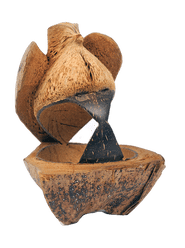Presented by Museum of the Peace Corps Experience and American University Museum
Mid-twentieth century
Chuuk Lagoon, Micronesia
Coconut, 8 x 5 1/2 x 5 1/2 in.
Collection, Museum of the Peace Corps Experience
Gift of Jack and Anne Weiss, Micronesia, Chuck Lagoon, 1966–68

Anne and I had been married only four weeks when we entered Peace Corps training in Key West, Florida. We received intensive training in the Chuukese language and learned methods for teaching ESL (English as a Second Language). Once we arrived at Chuuk High School, I taught math and outboard motor mechanics, as water travel was essential in Micronesia. Anne taught girls sewing, nutrition, and health.
One item we brought back that closely reflects Micronesian culture is a student-crafted bird image made from a coconut shell.
A common greeting in Chuukese is literally translated as “there is food” rather than “hello.” Such was the significance of the coconut in daily life. With machete in hand, your Chuukese friend might climb a nearby palm to bring down a ripe coconut. You drink the milk. You eat the chopped meat. You take some of the fiber with you to use in place of toilet paper.
Everywhere you go—from your sleeping mat to thatched roofs, woven baskets, or the rope in the dugout that transports you to another island—coconut goes with you. Dried coconut, called copra, is Micronesia’s most important agricultural export.
The bird represented in the student’s gift also reminded us that Chuukese people can navigate open oceans in their sailing canoes—without GPS. In addition to reading the waves and stars, they observe nearby birds to find their bearings.
Six days after returning from Micronesia I was drafted and sent to fight in Vietnam. Both were life-changing experiences—but of the two, I would say that the Peace Corps changed me more profoundly.
The Committee for a Museum of the Peace Corps Experience is a 501(c)(3) private nonprofit organization. Tax ID: EIN # 93-1289853
The Museum is not affiliated with the U.S. Peace Corps and not acting on behalf of the U.S. Peace Corps.
Museum of the Peace Corps Experience © 2024. All Rights Reserved.